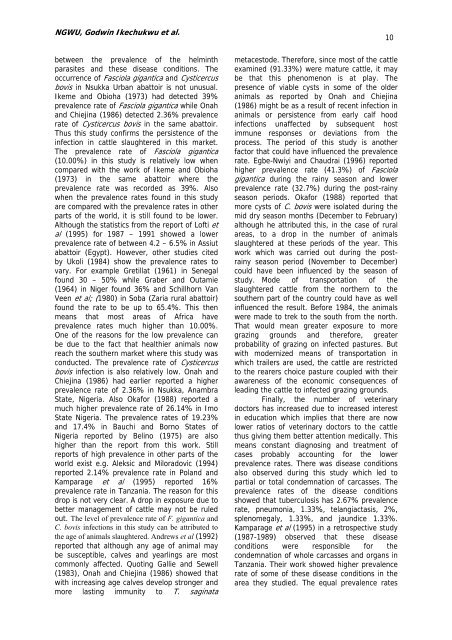Length-weight relationship of fishes from Anambra ... - Zoo-unn.org
Length-weight relationship of fishes from Anambra ... - Zoo-unn.org
Length-weight relationship of fishes from Anambra ... - Zoo-unn.org
- No tags were found...
You also want an ePaper? Increase the reach of your titles
YUMPU automatically turns print PDFs into web optimized ePapers that Google loves.
NGWU, Godwin Ikechukwu et al.between the prevalence <strong>of</strong> the helminthparasites and these disease conditions. Theoccurrence <strong>of</strong> Fasciola gigantica and Cysticercusbovis in Nsukka Urban abattoir is not unusual.Ikeme and Obioha (1973) had detected 39%prevalence rate <strong>of</strong> Fasciola gigantica while Onahand Chiejina (1986) detected 2.36% prevalencerate <strong>of</strong> Cysticercus bovis in the same abattoir.Thus this study confirms the persistence <strong>of</strong> theinfection in cattle slaughtered in this market.The prevalence rate <strong>of</strong> Fasciola gigantica(10.00%) in this study is relatively low whencompared with the work <strong>of</strong> Ikeme and Obioha(1973) in the same abattoir where theprevalence rate was recorded as 39%. Alsowhen the prevalence rates found in this studyare compared with the prevalence rates in otherparts <strong>of</strong> the world, it is still found to be lower.Although the statistics <strong>from</strong> the report <strong>of</strong> L<strong>of</strong>ti etal (1995) for 1987 – 1991 showed a lowerprevalence rate <strong>of</strong> between 4.2 – 6.5% in Assiutabattoir (Egypt). However, other studies citedby Ukoli (1984) show the prevalence rates tovary. For example Gretillat (1961) in Senegalfound 30 – 50% while Graber and Outamie(1964) in Niger found 36% and Schillhorn VanVeen et al; (1980) in Soba (Zaria rural abattoir)found the rate to be up to 65.4%. This thenmeans that most areas <strong>of</strong> Africa haveprevalence rates much higher than 10.00%.One <strong>of</strong> the reasons for the low prevalence canbe due to the fact that healthier animals nowreach the southern market where this study wasconducted. The prevalence rate <strong>of</strong> Cysticercusbovis infection is also relatively low. Onah andChiejina (1986) had earlier reported a higherprevalence rate <strong>of</strong> 2.36% in Nsukka, <strong>Anambra</strong>State, Nigeria. Also Okafor (1988) reported amuch higher prevalence rate <strong>of</strong> 26.14% in ImoState Nigeria. The prevalence rates <strong>of</strong> 19.23%and 17.4% in Bauchi and Borno States <strong>of</strong>Nigeria reported by Belino (1975) are alsohigher than the report <strong>from</strong> this work. Stillreports <strong>of</strong> high prevalence in other parts <strong>of</strong> theworld exist e.g. Aleksic and Miloradovic (1994)reported 2.14% prevalence rate in Poland andKamparage et al (1995) reported 16%prevalence rate in Tanzania. The reason for thisdrop is not very clear. A drop in exposure due tobetter management <strong>of</strong> cattle may not be ruledout. The level <strong>of</strong> prevalence rate <strong>of</strong> F. gigantica andC. bovis infections in this study can be attributed tothe age <strong>of</strong> animals slaughtered. Andrews et al (1992)reported that although any age <strong>of</strong> animal maybe susceptible, calves and yearlings are mostcommonly affected. Quoting Gallie and Sewell(1983), Onah and Chiejina (1986) showed thatwith increasing age calves develop stronger andmore lasting immunity to T. saginatametacestode. Therefore, since most <strong>of</strong> the cattleexamined (91.33%) were mature cattle, it maybe that this phenomenon is at play. Thepresence <strong>of</strong> viable cysts in some <strong>of</strong> the olderanimals as reported by Onah and Chiejina(1986) might be as a result <strong>of</strong> recent infection inanimals or persistence <strong>from</strong> early calf hoodinfections unaffected by subsequent hostimmune responses or deviations <strong>from</strong> theprocess. The period <strong>of</strong> this study is anotherfactor that could have influenced the prevalencerate. Egbe-Nwiyi and Chaudrai (1996) reportedhigher prevalence rate (41.3%) <strong>of</strong> Fasciolagigantica during the rainy season and lowerprevalence rate (32.7%) during the post-rainyseason periods. Okafor (1988) reported thatmore cysts <strong>of</strong> C. bovis were isolated during themid dry season months (December to February)although he attributed this, in the case <strong>of</strong> ruralareas, to a drop in the number <strong>of</strong> animalsslaughtered at these periods <strong>of</strong> the year. Thiswork which was carried out during the postrainyseason period (November to December)could have been influenced by the season <strong>of</strong>study. Mode <strong>of</strong> transportation <strong>of</strong> theslaughtered cattle <strong>from</strong> the northern to thesouthern part <strong>of</strong> the country could have as wellinfluenced the result. Before 1984, the animalswere made to trek to the south <strong>from</strong> the north.That would mean greater exposure to moregrazing grounds and therefore, greaterprobability <strong>of</strong> grazing on infected pastures. Butwith modernized means <strong>of</strong> transportation inwhich trailers are used, the cattle are restrictedto the rearers choice pasture coupled with theirawareness <strong>of</strong> the economic consequences <strong>of</strong>leading the cattle to infected grazing grounds.Finally, the number <strong>of</strong> veterinarydoctors has increased due to increased interestin education which implies that there are nowlower ratios <strong>of</strong> veterinary doctors to the cattlethus giving them better attention medically. Thismeans constant diagnosing and treatment <strong>of</strong>cases probably accounting for the lowerprevalence rates. There was disease conditionsalso observed during this study which led topartial or total condemnation <strong>of</strong> carcasses. Theprevalence rates <strong>of</strong> the disease conditionsshowed that tuberculosis has 2.67% prevalencerate, pneumonia, 1.33%, telangiactasis, 2%,splenomegaly, 1.33%, and jaundice 1.33%.Kamparage et al (1995) in a retrospective study(1987-1989) observed that these diseaseconditions were responsible for thecondemnation <strong>of</strong> whole carcasses and <strong>org</strong>ans inTanzania. Their work showed higher prevalencerate <strong>of</strong> some <strong>of</strong> these disease conditions in thearea they studied. The equal prevalence rates10

















